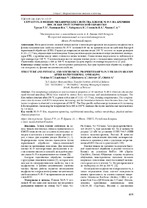| dc.contributor.author | Трухан, Р. Э. | ru |
| dc.contributor.author | Лапицкая, В. А. | ru |
| dc.contributor.author | Хабарова, А. В. | ru |
| dc.contributor.author | Соловьёв, Я. А. | ru |
| dc.contributor.author | Чижик, С. А. | ru |
| dc.coverage.spatial | Минск | ru |
| dc.date.accessioned | 2023-12-21T07:32:25Z | |
| dc.date.available | 2023-12-21T07:32:25Z | |
| dc.date.issued | 2023 | |
| dc.identifier.citation | Структура и физико-механические свойства пленок Ni-Pt-V на кремнии после быстрой термической обработки = Structure and physical and mechanical properties of Ni-Pt-V films on silicon after rapid thermal annealing / Р. Э. Трухан [и др.] // Приборостроение-2023 : материалы 16-й Международной научно-технической конференции, 15-17 ноября 2023 года, Минск, Республика Беларусь / редкол.: О. К. Гусев (пред.) [и др.]. – Минск : БНТУ, 2023. – С. 419-420. | ru |
| dc.identifier.uri | https://rep.bntu.by/handle/data/138606 | |
| dc.description.abstract | Методами атомно-силовой микроскопии и наноиндентирования исследованы морфология и физико-механические свойства пленок Ni-Pt-V толщиной 40 нм на кремнии после воздействия быстрой термической обработки (БТО). Структура поврехности пленки после 350 °С состоит из зерен размером 11,81–17,77 нм, образующих конгломераты. Размер конгломератов уменьшается при увеличении темпера- туры БТО, а границы между ними становятся менее четкими. Самая низкая шероховатость наблюдается при температуре 350 °С. Удельная поверхностна энергия пленки растет с повышением температуры БТО. Увеличение температуры с 400 до 500 °С повышает модуль упругости и микротвердость в 3,4 раза. | ru |
| dc.language.iso | ru | ru |
| dc.publisher | БНТУ | ru |
| dc.title | Структура и физико-механические свойства пленок Ni-Pt-V на кремнии после быстрой термической обработки | ru |
| dc.title.alternative | Structure and physical and mechanical properties of Ni-Pt-V films on silicon after rapid thermal annealing | ru |
| dc.type | Working Paper | ru |
| local.description.annotation | The morphology and physical and mechanical properties of 40 nm thick Ni-Pt-V films on silicon after rapid thermal annealing (RTA) were studied by atomic force microscopy and nanoindentation techniques. The film surface structure after 350 °C is grains with a size of 11.81–17.77 nm, forming conglomerates. The conglomerates size decreases with RTA temperature increasing, and the boundaries between them become less clear. The lowest roughness is observed at a temperature of 350 °C. The film specific surface energy increases with increasing RTA temperature. Increasing the temperature from 400 to 500 °C increases the elastic modulus and microhardness by 3.4 times. | ru |

